Stories of Korea’s nine seowon
Introduction to 9 seowon, UNESCO World Heritage Sites
The hub of sarim activityByeongsanseowon Andong (Historic Site No. 260)
“Think only of good works, with all your strength (力念善事);
Do only good works, with all your strength (力行善事).”
All sound files
Important functions of seowon
- Outline
- Veneration
- Learning
- Interaction
- Other aspects
Outline
“Think only of good works, with all your strength (力念善事);
Do only good works, with all your strength (力行善事).”
Do only good works, with all your strength (力行善事).”

Scenery of Byeongsanseowon
The above is a poem by Ryu Seong-ryong (1542-1607). Although short, it is very difficult to actually put into practice.
Ryu moved Pungak Seodang, which was in Pungsan-eup, to the site of Byeongsanseowon. After Ryu’s death, local literati built a shrine (Jondeoksa) to commemorate him inside Pungak Seodang, which eventually became a seowon. Four years later, the name was changed to Byeongsanseowon, based on the name of the mountain that surrounds the seowon from across the river like a folding screen (byeongpung in Korean). In 1863, it became a royally supported seowon after King Cheoljong bestowed a name board inscribed with the name “Byeongsanseowon.”
Ryu moved Pungak Seodang, which was in Pungsan-eup, to the site of Byeongsanseowon. After Ryu’s death, local literati built a shrine (Jondeoksa) to commemorate him inside Pungak Seodang, which eventually became a seowon. Four years later, the name was changed to Byeongsanseowon, based on the name of the mountain that surrounds the seowon from across the river like a folding screen (byeongpung in Korean). In 1863, it became a royally supported seowon after King Cheoljong bestowed a name board inscribed with the name “Byeongsanseowon.”
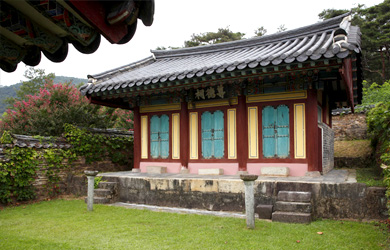
Jondeoksa
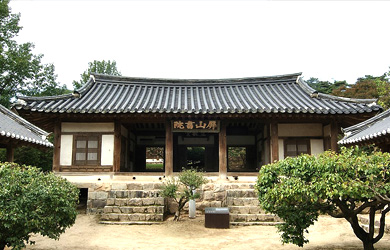
Ipgyodang
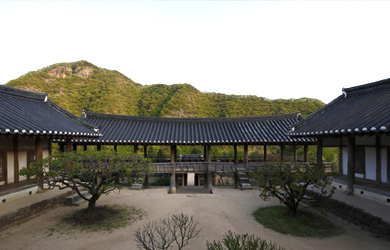
Mandaeru
Byeongsanseowon is an example of how the seowon’s primary role of education was broadened to include serving as a site for public discourse. It is the seowon that produced the first sangso, or petition to the king, which was signed by thousands of people. Byeongsanseowon always tried to respect local opinion on important matters of state, as evidenced by the many old documents that the seowon still has today.
After passing the “red blossom shade” of the crape myrtle tree and entering through Bokryemun, the three-doored main gate, one comes face to face with Byeongsanseowon’s landmark feature: Mandaeru. This pavilion, which has no walls, offers a view of the wide, sandy banks of Nakdonggang River and Byeongsan Mountain. “Mandae” comes from a verse written by Tang poet Du Fu, “The mountain, which is spread like a green folding screen, is beautiful to face at sunset (翠屛宜晩對).” As suggested by the pavilion’s name, the view of the greenery of Byeongsan Mountain across the river at sunset is beautiful, with the sun seeming to light up the river waters. Byeongsanseowon’s buildings may not be elaborate, but they certainly achieve an elegant harmony with nature, offering a good example of how to create a space in which nature and people can truly become one.

Jeongheojae
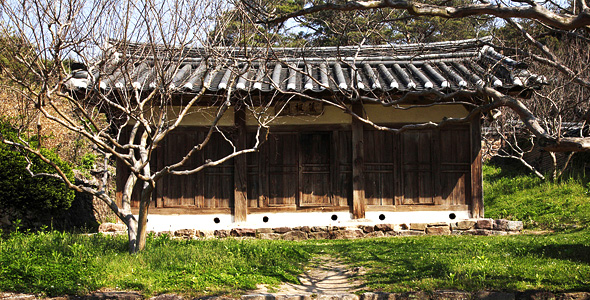
Jangpangak
The front area of the seowon is occupied by Ipgyodang, whose name means “to carry out proper teaching.” The name alone shows how much the literati believed in restraint of both mind and body. The student dormitories, Dongjikjae and Jeongheojae, face one another. Jangpangak, which stored the woodblocks used to print books as well as completed books, is behind Ipgyodang to the left. It was intentionally set apart from the seowon’s other buildings to minimize damage in the event of a fire. Behind both buildings is the shrine, Jondeoksa. The positioning of the shrine behind the learning area to the east is a characteristic of seowon built by members of the Yi Hwang (Toegye) school.
All of the spaces of Byeongsanseowon were devoted to the ideal of the “benevolent, righteous person” taught by Neo-Confucianism: the veneration space, for commemorating the accomplishments of great scholars; the learning space, for reading, debating, and exploring the principles of the world; and the interaction space, for realizing the principles of truth by viewing the changes of nature.
Byeongsanseowon is listed under two UNESCO World Heritage Sites: “Historic Villages of Korea: Hahoe and Yangdong (2010)” and “Seowon, Korean Neo-Confucian Academies (2019).”
All of the spaces of Byeongsanseowon were devoted to the ideal of the “benevolent, righteous person” taught by Neo-Confucianism: the veneration space, for commemorating the accomplishments of great scholars; the learning space, for reading, debating, and exploring the principles of the world; and the interaction space, for realizing the principles of truth by viewing the changes of nature.
Byeongsanseowon is listed under two UNESCO World Heritage Sites: “Historic Villages of Korea: Hahoe and Yangdong (2010)” and “Seowon, Korean Neo-Confucian Academies (2019).”
Veneration at Byeongsanseowon
The center of the shrine features the spiritual tablets of Ryu Seong-ryong, with those of his son, Ryu Jin, nearby. At Byeongsanseowon, there is always a step conducted before eumbokrye in which officiants check for errors. When a young officiant says, “Let’s discuss the rite,” the others ask, “Was there anything wrong with the ritual?” When the discussion is finished, everyone says, “Let’s end the discussion.” In other words, everyone does their best until the very last moment. The Chunchuhyangsa is conducted annually on the third and ninth lunar months.

Jondeoksa
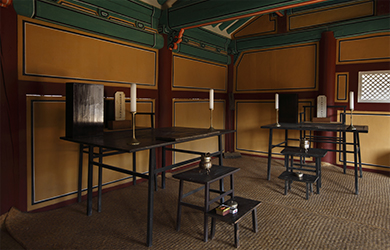
Inside Jonseoksa
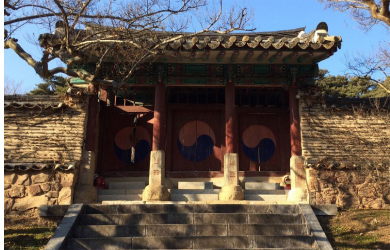
Naesammun
Venerated individuals
Ryu Seong-ryong, a disciple of Yi Hwang, started his life of public service at the age of 24. During the Imjin Invasions, Ryu served as chief state councilor, tasked with overseeing administrative affairs and the military. He wrote many books, including the famous Jingbirok (Record of the Progress of War Situation) and Record of Military Affairs. He is also known as a friend and sponsor of General Yi Sun-shin. In his last years, Ryu lived in Hahoe Village, where he continued making a name for himself through Taoism, various writings, calligraphy, and good works for the community. During these final years, Ryu concentrated on conducting academic research and cultivating young scholars.
Ryu Jin was Ryu Seong-ryong’s third son and a bureaucrat and scholar of mid-Joseon. After the Imjin Invasions, Ryu studied under his father. At age 29, Ryu Jin passed the Samasi exam. In general, Ryu Jin was regarded as having lived “in a proper manner that befits a son of Ryu Seong-ryong.” He also wrote a book of poems (Writings of Suam).
Ryu Jin was Ryu Seong-ryong’s third son and a bureaucrat and scholar of mid-Joseon. After the Imjin Invasions, Ryu studied under his father. At age 29, Ryu Jin passed the Samasi exam. In general, Ryu Jin was regarded as having lived “in a proper manner that befits a son of Ryu Seong-ryong.” He also wrote a book of poems (Writings of Suam).
Learning at Byeongsanseowon
Starting the mid-17th century, most seowon began to stress veneration over learning. Despite this milieu, Byeongsanseowon maintained its strong tradition of learning until the late 18th century. According to some records, 107 people studied and debated Great Learning for four days in a format known as “full reading.” Another document reports that students from the age of 18 to their late 40s studied the following Confucian texts (in this order): Great Learning, Doctrine of the Mean, Book of Historical Documents, Book of Odes, Zhu Xi, The Analects, Commentary on the Book of Historical Documents, Classic of the Mind, Book of Changes, Mencius, and Book of Rites. Byeongsanseowon’s dedication to learning continued even after the start of Korea’s modern era. In 1946, seowon assets were used to create the Byeongsan Educational Foundation, which operates Pungsan Middle and High School, both of which have a founding philosophy that stresses the values embodied by the seowon.

Ipgyodang
Interaction at Byeongsanseowon
There were two rest areas at Byeongsanseowon: Mandaeru and the natural scenery that could be seen from this pavilion. As suggested by the name of the seowon, which came from a verse of Du Fu’s poetry, the spaces inhabited and created by Mandaeru are poetic in their beauty. A view from the pavilion includes the picturesque Byeongsan Mountain and Nakdonggang River (to the south), and the aerial view of the seowon itself is stunning as well. Students came to the pavilion to relax, compose poetry, and sing against the beautiful natural backdrop.
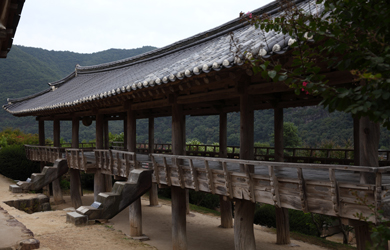
Mandaeru
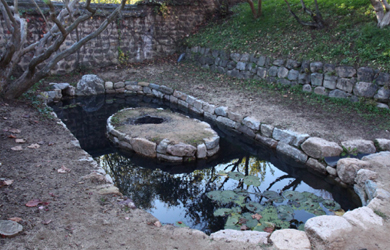
Gwangyeongji
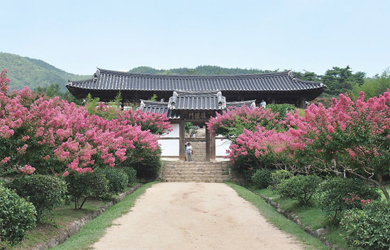
Bokryemun
Other aspects (cultural heritage items and memorial objects)
Ryu Seong-ryong was a bureaucrat and scholar who wrote many books. Jingbirok, now a National Treasure (No. 132), was hand-written by Ryu while living in Hahoe Village after the Imjin Invasions ended and he left government office. It is a very valuable historical record because of its detailed explanations of a seven-year period, covering such subjects as: the relationship between Joseon and Japan before the Imjin Invasions, the peoples’ revolts that occurred during the war, and how Ming China provided assistance. Miscellaneous Records After the War, Jinsarok (a collection of handwritten copies of the official documents Ryu submitted to the king while serving as chief state councilor), and Record of Military Affairs are also about Ryu’s experiences of the Imjin Invasions and have all been designated as Treasures.
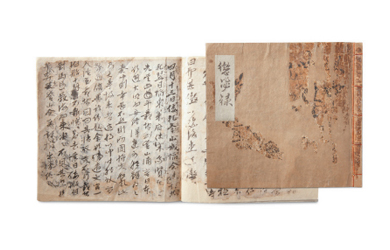
Jingbirok (Record of the Progress of the War)
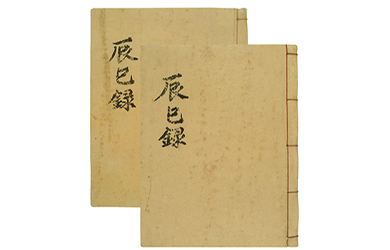
Ryu Seong-ryong’s documents related to the head family of the Ryu Seong-ryong clan (Treasure 160; Cultural Heritage Administration)

Mandaeru (Treasure No. 2104)
